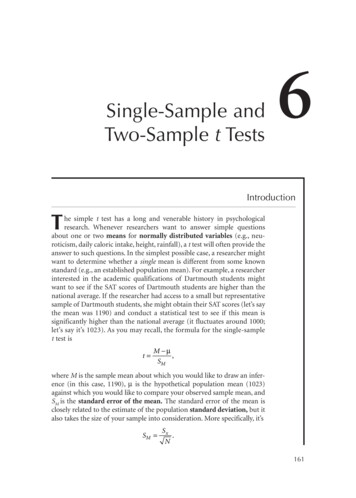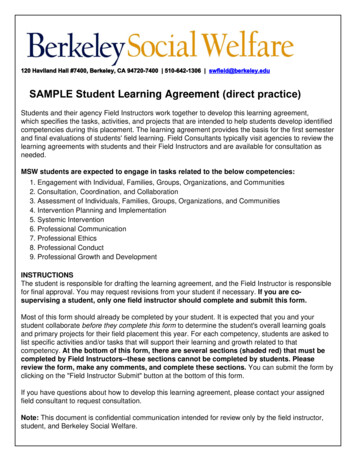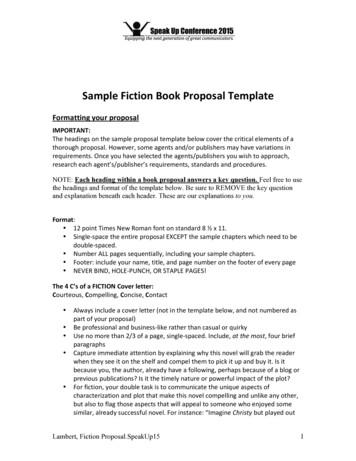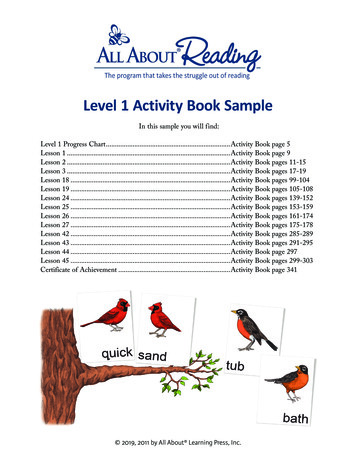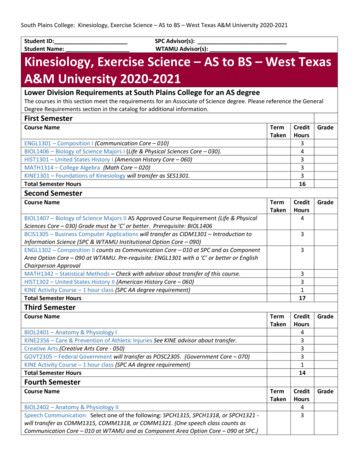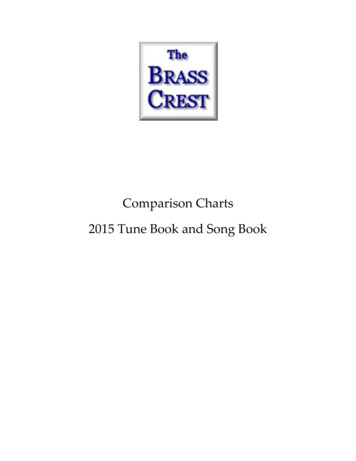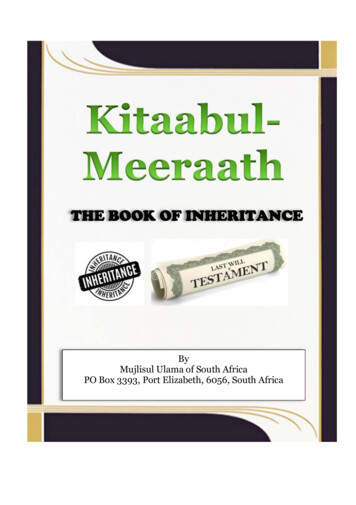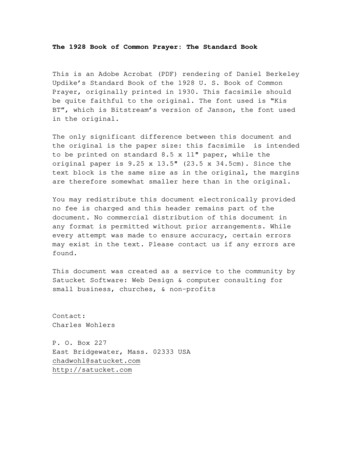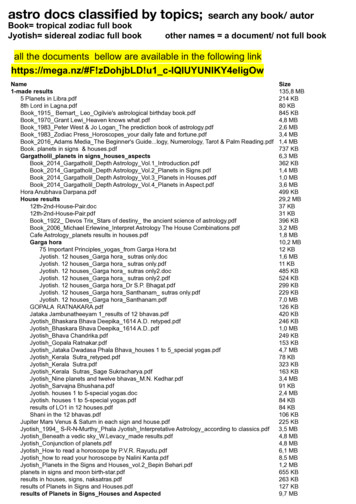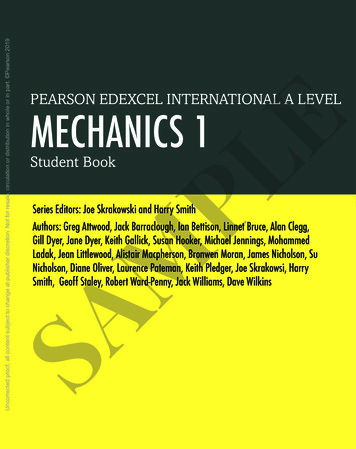
Transcription
MPLStudent BookEMECHANICS 1Series Editors: Joe Skrakowski and Harry SmithAuthors: Greg Attwood, Jack Barraclough, Ian Bettison, Linnet Bruce, Alan Clegg,Gill Dyer, Jane Dyer, Keith Gallick, Susan Hooker, Michael Jennings, MohammedLadak, Jean Littlewood, Alistair Macpherson, Bronwen Moran, James Nicholson, SuNicholson, Diane Oliver, Laurence Pateman, Keith Pledger, Joe Skrakowsi, HarrySmith, Geoff Staley, Robert Ward-Penny, Jack Williams, Dave WilkinsSAUncorrected proof, all content subject to change at publisher discretion. Not for resale, circulation or distribution in whole or in part. Pearson 2019PEARSON EDEXCEL INTERNATIONAL A LEVEL
Copies of official specifications for all Pearson qualifications may be found on thewebsite: https://qualifications.pearson.comText Pearson Education Limited 2018Edited by Eric PradelDesigned by Pearson Education Limited 2018Typeset by Tech-Set Ltd, Gateshead, UKOriginal illustrations Pearson Education Limited 2018Illustrated by Tech-Set Ltd, Gateshead, UKCover design by Pearson Education Limited 2018The rights of Greg Attwood, Jack Barraclough, Ian Bettison, Linnet Bruce, AlanClegg, Gill Dyer, Jane Dyer, Keith Gallick, Susan Hooker, Michael Jennings,Mohammed Ladak, Jean Littlewood, Alistair Macpherson, Bronwen Moran, JamesNicholson, Su Nicholson, Diane Oliver, Laurence Pateman, Keith Pledger, JoeSkrakowsi, Harry Smith, Geoff Staley, Robert Ward-Penny, Jack Williams and DaveWilkins to be identified as the authors of this work have been asserted by them inaccordance with the Copyright, Designs and Patents Act 1988.21 20 19 1810 9 8 7 6 5 4 3 2 1Endorsement does not cover any guidance on assessment activities or processes(e.g. practice questions or advice on how to answer assessment questions)included in the resource, nor does it prescribe any particular approach to theteaching or delivery of a related course.While the publishers have made every attempt to ensure that advice on thequalification and its assessment is accurate, the official specification andassociated assessment guidance materials are the only authoritative source ofinformation and should always be referred to for definitive guidance.Pearson examiners have not contributed to any sections in this resource relevant toexamination papers for which they have responsibility.Examiners will not use endorsed resources as a source of material for anyassessment set by Pearson. Endorsement of a resource does not mean that theresource is required to achieve this Pearson qualification, nor does it mean that itis the only suitable material available to support the qualification, and any resourcelists produced by the awarding body shall include this and other appropriateresources.MPLFirst published 2018Endorsement StatementIn order to ensure that this resource offers high-quality support for the associatedPearson qualification, it has been through a review process by the awarding body.This process confirms that this resource fully covers the teaching and learningcontent of the specification or part of a specification at which it is aimed. It alsoconfirms that it demonstrates an appropriate balance between the developmentof subject skills, knowledge and understanding, in addition to preparation forassessment.Ewww.pearsonglobalschools.comBritish Library Cataloguing in Publication DataA catalogue record for this book is available from the British LibraryISBN 978 1 292 24467 9Copyright noticeAll rights reserved. No part of this publication may be reproduced in any form or byany means (including photocopying or storing it in any medium by electronic meansand whether or not transiently or incidentally to some other use of this publication)without the written permission of the copyright owner, except in accordance withthe provisions of the Copyright, Designs and Patents Act 1988 or under the termsof a licence issued by the Copyright Licensing Agency, Barnard's Inn, 86 FetterLane, London, EC4A 1EN (www.cla.co.uk). Applications for the copyright owner’swritten permission should be addressed to the publisher.Printed by Neografia in SlovakiaPicture CreditsThe authors and publisher would like to thank the following individuals andorganisations for permission to reproduce photographs:(Key: b-bottom; c-centre; l-left; r-right; t-top)Fotolia.com: Arousa 54; Getty Images: Jeff Schultz 39; Shutterstock.com:Algonga 7, Carlos Castilla 101, Carlos. E. Santa Maria 1, Joggie Botma 7, Lane V.Erickson 84, mbolina 112, Sinesp 10, 123RF.com: dmitrimaruta 129SAUncorrected proof, all content subject to change at publisher discretion. Not for resale, circulation or distribution in whole or in part. Pearson 2019Published by Pearson Education Limited, 80 Strand, London, WC2R 0RL.Cover images: Front: Getty Images: Werner Van SteenInside front cover: Shutterstock.com: Dmitry LobanovAll other images Pearson EducationAll artwork Pearson Education
iiiCOURSE STRUCTURE ivABOUT THIS BOOK viEXTRA ONLINE CONTENT 1 MATHEMATICAL MODELS IN MECHANICS MPL2 CONSTANT ACCELERATION viiixEQUALIFICATION AND ASSESSMENT OVERVIEW 1103 VECTORS IN MECHANICS 394 DYNAMICS OF A PARTICLE MOVING IN ASTRAIGHT LINE 54REVIEW EXERCISE 1 795 FORCES AND FRICTION 846 MOMENTUM AND IMPULSE 1017 STATICS OF A PARTICLE 1128 MOMENTS 129SAUncorrected proof, all content subject to change at publisher discretion. Not for resale, circulation or distribution in whole or in part. Pearson 2019CONTENTSREVIEW EXERCISE 2 146EXAM PRACTICE 150GLOSSARY 153ANSWERS 155INDEX 166
COURSE STRUCTURECHAPTER 1 MATHEMATICALMODELS IN MECHANICS 1CHAPTER 4 DYNAMICS OFA PARTICLE MOVING IN ASTRAIGHT LINE 5421.2 MODELLING ASSUMPTIONS 44.1 FORCE DIAGRAMS 551.3 QUANTITIES AND UNITS 64.2 FORCES AS VECTORS 58CHAPTER REVIEW 1 84.3 FORCES AND ACCELERATION 60E1.1 CONSTRUCTING A MODEL 4.4 MOTION IN TWO DIMENSIONS 644.5 CONNECTED PARTICLES 67104.6 PULLEYS 712.1 DISPLACEMENT–TIME GRAPHS 11CHAPTER REVIEW 4 752.2 VELOCITY–TIME GRAPHS 132.3 ACCELERATION-TIME GRAPHS 17REVIEW EXERCISE 1 792.4 CONSTANT ACCELERATIONFORMULAE 1 192.5 CONSTANT ACCELERATIONFORMULAE 2 24CHAPTER 5 FORCES ANDFRICTION 84MPLCHAPTER 2 CONSTANTACCELERATION 2.6 VERTICAL MOTION UNDER GRAVITY 29CHAPTER REVIEW 2 35CHAPTER 3 VECTORS INMECHANICS 393.1 WORKING WITH VECTORS 3.2 SOLVING PROBLEMS WITHVECTORS WRITTEN USINGI AND J NOTATION SAUncorrected proof, all content subject to change at publisher discretion. Not for resale, circulation or distribution in whole or in part. Pearson 2019iv405.1 RESOLVING FORCES 855.2 INCLINED PLANES 905.3 FRICTION 94CHAPTER REVIEW 5 99CHAPTER 6 MOMENTUM ANDIMPULSE 1016.1 MOMENTUM IN ONE DIMENSION 102426.2 CONSERVATION OF MOMENTUM 104CHAPTER REVIEW 6 3.3 THE VELOCITY OF A PARTICLEAS A VECTOR 453.4 SOLVING PROBLEMS INVOLVINGVELOCITY AND TIME USINGVECTORS 46CHAPTER REVIEW 3 50109
CHAPTER 7 STATICS OF APARTICLE 1127.1 STATIC PARTICLES 1137.2 MODELLING WITH STATICS 1177.3 FRICTION AND STATIC PARTICLES 121126CHAPTER 8 MOMENTS 1291308.2 RESULTANT MOMENTS 1328.3 EQUILIBRIUM 1338.4 CENTRES OF MASS 1368.5 TILTING 139CHAPTER REVIEW 8 141MPL8.1 MOMENTS ECHAPTER REVIEW 7 REVIEW EXERCISE 2 146EXAM PRACTICE 150GLOSSARY 153ANSWERS 155SAUncorrected proof, all content subject to change at publisher discretion. Not for resale, circulation or distribution in whole or in part. Pearson 2019COURSE STRUCTUREINDEX 166v
ABOUT THIS BOOKABOUT THIS BOOKThe following three overarching themes have been fully integrated throughout the Pearson EdexcelInternational Advanced Level in Mathematics series, so they can be applied alongside your learningand practice. Rigorous and consistent approach throughout Notation boxes explain key mathematical language and symbols Opportunities to critique arguments and justify methods2. Mathematical problem-solvingE1. Mathematical argument, language and proofThe Mathematical Problem-Solving Cycle Hundreds of problem-solving questions, fully integratedinto the main exercisesMPLspecify the problem Problem-solving boxes provide tips and strategiesinterpret results Structured and unstructured questions to build confidence Challenge questions provide extra stretchcollect informationprocess andrepresent information3. Mathematical modelling Dedicated modelling sections in relevant topics provide plenty of practice where you need it Examples and exercises include qualitative questions that allow you to interpret answers in thecontext of the modelAccess an onlinedigital edition usingthe code at thefront of the book.Finding your way around the book4 DYNAMICS OF APARTICLE MOVINGIN A STRAIGHT LINESAUncorrected proof, all content subject to change at publisher discretion. Not for resale, circulation or distribution in whole or in part. Pearson 2019viEach chapter starts with alist of Learning objectivesThe Prior knowledgecheck helps make sureyou are ready to start thechapter4.14.2Learning objectivesbe able to:A er completing this chapter you shouldresultant forces Draw force diagrams and calculaterst law of motion Understand and use Newton’s fivectors Calculate resultant forces by addinglaw of motion, F ma Understand and use Newton’s secondforces and acceleration Apply Newton’s second law to vectorparticlesconnected Solve problems involvinglaw of motion Understand and use Newton’s third Solve problems involving pulleys pages 71–73 pages 71–73 pages 74–76 pages 76–80 pages 80–83 pages 83–86 pages 84–86 pages 87-91Prior knowledge check1Calculate:a (2i j) (3i – 4j)b (–i 3j) – (3i – j) International GCSE MathematicsThe diagram shows aright-angled triangle.12 cmWork out:aa the length of the15 cmhypotenuseb the size of the angle a.MathematicsGCSEl InternationaGive your answers correct to 1 d.p.–2at a constant rate of 1.5 m s .3 A car starts from rest and accelerateser 12 seconds.a Work out the velocity of the car athe car to decelerate atcausingbrakes,drivertheA er 12 seconds,–2a constant rate of 1 m s .from the instant the driverb Calculate the distance the car travels Chapter 3brakes until the car comes to rest.2The real world applications ofthe maths you are about to learnare highlighted at the start of thechapterThe weight of an air–searescue crew man isbalanced by the tension inthe cable. By modelling theforces in this situation, youcan calculate how strongthe cable needs to be.24/05/2018 10:2004-Chapter 4 070-082.indd 58
EProblem-solving boxesprovide hints, tips andstrategies, and Watchout boxes highlightareas where studentsoften lose marks intheir examsviiExercises are packedwith exam-stylequestions to ensureyou are ready for theexamsMPLExercise questionsare carefully gradedso they increase indifficulty and graduallybring you up to examstandardChallenge boxes giveyou a chance to tacklesome more difficultquestionsExam-style questionsare flagged with EProblem-solvingquestions are flaggedwith PEach chapter ends with a Chapter reviewand a Summary of key pointsTransferable skills aresignposted where theynaturally occur in theexercises and examples.Each section beginswith an explanationand key learningpointsStep-by-step workedexamples focus on thekey types of questionsyou’ll need to tackleAfter every few chapters, a Review exercisehelps you consolidate your learning withlots of exam-style questionsSAUncorrected proof, all content subject to change at publisher discretion. Not for resale, circulation or distribution in whole or in part. Pearson 2019ABOUT THIS BOOKA full practice paper at the back of thebook helps you prepare for the real thing
QUALIFICATION ANDASSESSMENT OVERVIEWQualification and content overviewEMechanics 1 (M1) is an optional unit in the following qualifications:International Advanced Subsidiary in MathematicsInternational Advanced Subsidiary in Further MathematicsInternational Advanced Level in MathematicsInternational Advanced Level in Further MathematicsMPLAssessment overviewThe following table gives an overview of the assessment for this unit.We recommend that you study this information closely to help ensure that you are fully prepared forthis course and know exactly what to expect in the assessment.UnitPercentageM1: Mechanics 1Paper code WME01/01133 3 % of IASMarkTimeAvailability751 hour 30 minsJanuary, June and October216 3 % of IALFirst assessment June 2019IAS – International Advanced Subsidiary, IAL – International Advanced A LevelAssessment objectives and weightingsMinimumweighting inIAS and IALAO1Recall, select and use their knowledge of mathematical facts, concepts and techniques in avariety of contexts.30%AO2Construct rigorous mathematical arguments and proofs through use of precise statements,logical deduction and inference and by the manipulation of mathematical expressions,including the construction of extended arguments for handling substantial problemspresented in unstructured form.30%AO3Recall, select and use their knowledge of standard mathematical models to representsituations in the real world; recognise and understand given representations involvingstandard models; present and interpret results from such models in terms of the originalsituation, including discussion of the assumptions made and refinement of such models.10%AO4Comprehend translations of common realistic contexts into mathematics; use the results ofcalculations to make predictions, or comment on the context; and, where appropriate, readcritically and comprehend longer mathematical arguments or examples of applications.5%AO5Use contemporary calculator technology and other permitted resources (such as formulaebooklets or statistical tables) accurately and efficiently; understand when not to use suchtechnology, and its limitations. Give answers to appropriate accuracy.5%SAUncorrected proof, all content subject to change at publisher discretion. Not for resale, circulation or distribution in whole or in part. Pearson 2019viii QUALIFICATION AND ASSESSMENT OVERVIEW
ixRelationship of assessment objectives to unitsAssessment objectiveM1Marks out of 75%AO1AO2AO3AO4AO520–2520–25
Student Book SAMPLE. PEARSON EDEXCEL INTERNATIONAL A LEVEL. MECHANICS 1. Student Book. Series Editors: Joe Skrakowski and Harry Smith Authors: Greg Attwood, Jack Barraclough, Ian Bettison, Linnet Bruce, Alan Clegg, Gill Dyer, Jane Dyer, Keith Gallick, Susan Hooker, Michael Jennings, Mohammed Ladak, Jean Littlewood, Alistair Macpherson, Bronwen .
